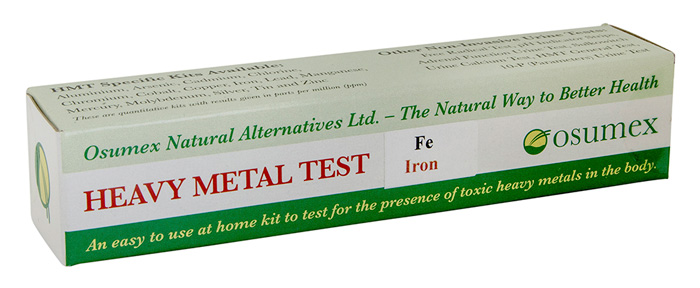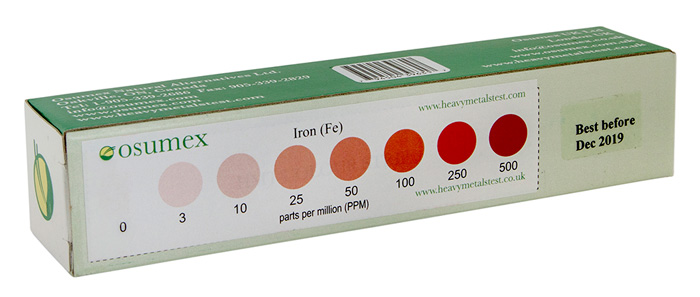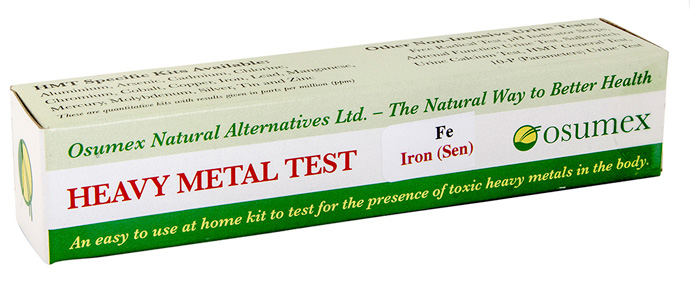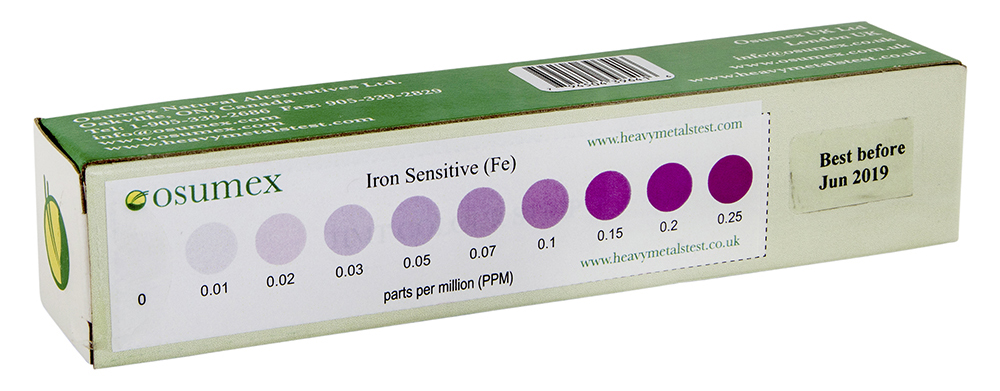Iron Kit (Reg)
how to test |
Iron Test kit (Sen)
how to test |
Iron Overload
Hemochromatosis |
|
|
| Water Test Kit (2-test pack) |
| Adrenal Function Urine Test |
| Sulkowitch Urine (Calcium) Test |
|
|
|
IRON DEFICIENCY - ANAEMIA
Number 26 on the "periodic table" of elements
Tests the presence of ions of iron to a high degree of accuracy to
detect contamination in the body and on a wide range of materials in your environment
Iron Deficiency Disease - Anaemia
What is anaemia?
You get anaemia when you don't have enough red blood cells. This makes it difficult for your blood to carry
oxygen, causing unusual tiredness and other symptoms.
The number of red blood cells can drop if there is:
- a reduction in the number of red blood cells produced
- an increase in the loss of red blood cells.
Why does a lack of iron cause anaemia?
Red blood cells are made in the bone marrow and circulate in the blood. They only have a life expectancy of about four months.
The body needs iron, vitamin B12 and folic acid (one of the B group of vitamins) to produce more red blood cells.
If there is a lack of one or more of these nutrients, anaemia will develop.
Iron deficiency anaemia is the most common type of anaemia. In the UK 8 per cent of women have this type of anaemia.
Iron deficiency is more frequent in women who smoke, eat a diet low in iron and have heavy periods.
What causes this type of anaemia?
Most childhood cases are caused by a poor diet that contains little iron.
In adults the most common cause is losing blood faster than the body can replace it.
- A lack of iron in the diet is common in vegans and vegetarians because the main dietary source is red meat
- Babies can develop iron deficiency, especially if they are premature. Storing iron is not usually completed until the final stages
of pregnancy
- The body needs more iron when a large amount of cell divisions occur, such as in pregnancy and during periods of rapid childhood growth
- Loss of blood through heavy menstruation can deplete iron stores
- Diseases of the small intestine such as gluten intolerance (coeliac disease) and Crohn's disease (inflammation of the intestine) can reduce
its ability to absorb iron.
- If there seems to be no cause for the iron deficiency, consult your doctor. Less commonly, small ruptures in the intestine due to cancer or
polyps (small growths), and ulcers in the stomach and small intestine can cause iron deficiency anaemia. The loss of blood from the digestive
tract may be so slight as to be undetected on its own
What are the symptoms of iron-deficiency anaemia?
If a person is otherwise healthy, it can take some time for the signs of anaemia to appear.
- The first symptoms will be tiredness and palpitations (awareness of heartbeat).
- Shortness of breath and dizziness (fainting) are also common.
- If the anaemia is severe, you may experience angina (chest pain), headache or leg pains (intermittent claudication).
Besides these general symptoms of anaemia, in pronounced and long-term cases of iron deficiency there will be:
- burning sensation in the tongue
- dryness in the mouth and throat
- sores at the corners of the mouth
- altered sense of touch
- brittle, spoon-shaped nails with vertical stripes and a tendency to fray
- pica (an insatiable craving for a specific food, eg liquorice)
- brittle hair
- difficulty swallowing
In rare cases iron deficiency can cause permanent changes to the soft lining in the throat (Plummer-Vinson syndrome). This condition is a
preliminary stage to cancer.
How is anaemia diagnosed?
A blood sample is taken and sent off to the laboratory. An analysis of the red blood cells is usually included with the result of the test.
In pronounced iron deficiency the red blood cells will be small and pale. Otherwise, further analysis is needed to examine the proteins called
ferritin and transferrin that are involved in the storage and transport of iron through the body. An alternative and inexpensive way to find
out about iron deficiency is to use Osumex HMT Iron Test kit to detect the level of iron in urine
How is it treated?
Iron tablets will rapidly reverse anaemia, so long as any underlying cause of blood loss has been treated. The tablets can irritate the
stomach and should be taken after food to prevent this.
Iron tablets may colour the stools black and cause constipation or diarrhoea.
There may be a need for intramuscular iron injections to be given instead of tablets, but this is far less common.
What can be done to avoid anaemia?
Eat a varied, well-balanced diet that contains foods from all the food groups (protein, carbohydrate, fat, fruit, vegetables).
Good sources of iron include liver, beef, wholemeal bread, cereals, eggs and dried fruit.
If you often get heavy periods, it's a good idea to seek medical advice because you may be at risk of anaemia.
If you are pregnant or planning to become pregnant, talk to your doctor about iron supplements.
Consult your doctor or professional healthcare giver immediately if you notice blood in your stools or urine.
Check out the iron in your body with our easy to use, home-based, HMT Iron Test Kit
 
Sample of a HMT Cobalt Regular Test kit
 
Sample of a HMT Iron Sensitive Test kit with color strip for results analysis
Osumex HM-Chelat is most effective in eliminating heavy metals contamination in the body

The above information is provided for general
educational purposes only. It is not intended to replace competent
health care advice received from a knowledgeable healthcare professional.
You are urged to seek healthcare advice for the treatment of any
illness or disease.
Health Canada and the FDA (USA) have not evaluated these
statements. This product is not intended to diagnose, treat, cure, or prevent
any disease.
|


